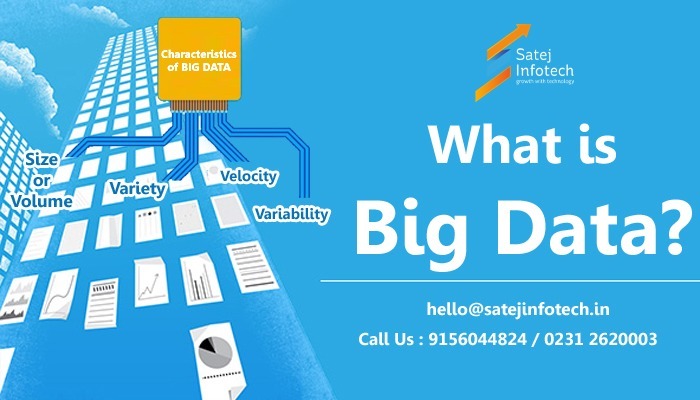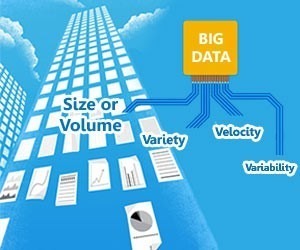What is Big Data?
Big data is nothing but a collection of huge amount of data that grows exponentially with time. It includes large amount of data that is complex and cannot be stored or processed using traditional management tools.

Let Us Understand Big Data With The Help Of Few Examples
The New York Stock exchange generates approximately 1TB data every day.
A survey reveals that about 500TB new data gets consumed on Facebook in the form of photos, videos, messages, comments, etc.
A single Jet engine generates around 10TB of data in 30 minutes of its flight time. With thousands of flights plying about, the data generated can reach to several Petabytes.
Big Data Can Be Divided Into 3 Broad Categories;
1. Structured
Data that can be accessed, processed and stored in a fixed format is known as structured data. The computer techniques have developed to a great extent and the format to work with a particular type of data is known in advance now. However, this does not help in cases where the data keeps growing to an extent that it touches multiple range of Zettabyte. That is where the term ‘big data’ originates. It can be challenging to process and store such large amount of data.
2. Unstructured
Data that is huge and has no proper structure to it is defined as unstructured data. This sort of data poses several challenges in terms of processing and obtaining a value of it. For instance, a heterogeneous data comprising of images, videos, text files etc can be considered as unstructured data. Several organizations have a huge amount of data but unfortunately are not aware of how to derive value out of it as most of the data is in unstructured format.
A best example to explain unstructured data is output by Google search.
3. Semi-Structured
This can be a combination of both structured as well as unstructured data. You can mistake the data to be in a structured format even though it may not be defined thoroughly. A data in XML file is a good example of semi-structured data.
What Are The Characteristics Of Big Data?
1. Size or Volume
From the name itself one can have a fair idea about the size of the data being huge. The size of any data is crucial as it helps determine a value out of that data. Also, must understand that just any data cannot be referred to as Big Data. The volume of the data is important in determining whether it can be referred to as Big Data or not. Hence, it can be safely said that the ‘volume’ of the data is an important characteristic that helps in determining if a data can be referred to as Big Data.
2. Variety
By variety, we mean both structured and unstructured data. Here, the data can be from several different sources. Earlier, most of the applications used data in the form of either spreadsheets or databases. Today, however, the scenario has changed and data can be of any form; videos, PDFs, audios, photos, monitoring devices and much more. Variety of data brings with uncertainty in terms of mining, analyzing and storing of data.
3. Velocity
This refers to the speed at which data is generated. The speed at which the data is generated and processed to meet the demand is what determines its real potential.
Velocity refers to the speed at which the data flows from various sources such as application logs, networks, business processes, social media sites, mobile devices, sensors, etc. The flow of data is continuous and huge in volume.
4. Variability
Sometimes data can be really inconsistent or variable. This hampers the process of handling data and managing it effectively.
Benefits Of Big Data
If you are able to process Big Data efficiently then it can offer you several benefits.
-Allows Businesses to Utilize Outside Intelligence and take Better Decisions
Businesses will be able to achieve their goals faster by accessing data from search engines and social media sites.
-Provide Better Customer Service
Big Data technologies have replaced the traditional methods of customer feedback. These new systems natural language processing along with Big data technologies are made use to evaluate and read customer responses.
-Better Operational Efficiency
‘Big Data’ technologies can be utilized as a landing zone for new data. After this the data can be moved to a data warehouse. This process can also help organizations to take care of data is not used frequently.
Big data technology helps organizations to identify any risk to product or service at an early stage
Why Do Organizations Need Big Data Technologies?
Big data technologies are needed to provide accurate analysis. This will enable a company to take better decisions which will result in cost reductions, improved operational efficiency and lower business risks..
In order to achieve this, an organization requires an infrastructure that can process and store huge volumes of structured and unstructured data. Also, they must ensure to protect data privacy and security.
Organizations can hire several vendors such as IBM, Amazon, Microsoft, etc to handle big data. There are two types of big data technologies;
Operational Big Data
This includes systems like MongoDB that provide real-time operational capabilities and interactive workloads where the data is primarily captured and stored.
NoSQL Big Data systems are designed to utilize the new cloud computing techniques that allow complex computations to be run efficiently and at a reasonable cost. Cloud computing is a well-known technique that has been in use since last one decade. This makes the operational big data workload a lot simpler, easy to manage, cheaper and faster.
In some cases, NoSQL systems use real-time data to provide insights about patterns and trends. Interestingly all this can be achieved with no additional infrastructure or data scientists and with minimal coding.
Analytical Big Data
Systems like MapReduce and Massively Parallel Processing (MPP) database systems come under Analytical Big Data systems. These systems can provide analytical capabilities for complex analysis that is included in all most all the data.
MapReduce includes a new method of analyzing data that is complementary to the capabilities provided by SQL. Another advantage of using MapReduce system is that it has a system that can be scaled up from a single server to multiple high and low end machines.
In general, MapReduce comprises of two parts.The Map function takes all the data , sorts it, filters it and places it in categories for better analysis. While the Reduce function combines all the data together and provides a summary of it. MapReduce originally was just a research work at Google but now has become a generic model for several technologies.
What Tools Can Be Used To Analyze Big Data?
The most established and influential tool is Apache Hadoop. It is a framework that allows processing and storing of large scale data. It is completely open source. The best part about using Hadoop is- It can run on commodity hardware. This makes it easy to be used on an existing data center and makes conducting analysis in the cloud simpler. Hadoop is divided into four main parts;
-The Hadoop Distributed File Systems or HDFS- it is a file system designed for high bandwidth.
-YARN- It is a platform that helps manage Hadoop’s resources and at the same time allows scheduling of programs to be run on Hadoop’s infrastructure.
-MapReduce- This has been already discussed above.
A common set of libraries for other modules to utilize.
In addition to these there are other tools which can be used to analyze big data. One such emerging tool is Apache Spark. This tool stores a lot of data in the memory for processing which allows faster analysis. Along with Hadoop Distributed File Sytems, Apache Spark also works well with other data stores such as Apache Cassandra, Open Stack Swift , etc. Apache Spark also makes testing and development easy as it can be run on a single local machine.
Once you understand how to handle big data, you will be able to resolve any problems. Also, you will get better insights as you tackle every step which will eventually improve your customer engagement strategies. This will only inspire you to put big data marketing strategies to work and help boost online and offline interaction with your customers.
If you are looking to create a career in Big data then get in touch as we have extensive big data courses that will help you get a deeper understanding about big data and land you in the right Big Data Job.
Contact us today to discuss your requirements.

